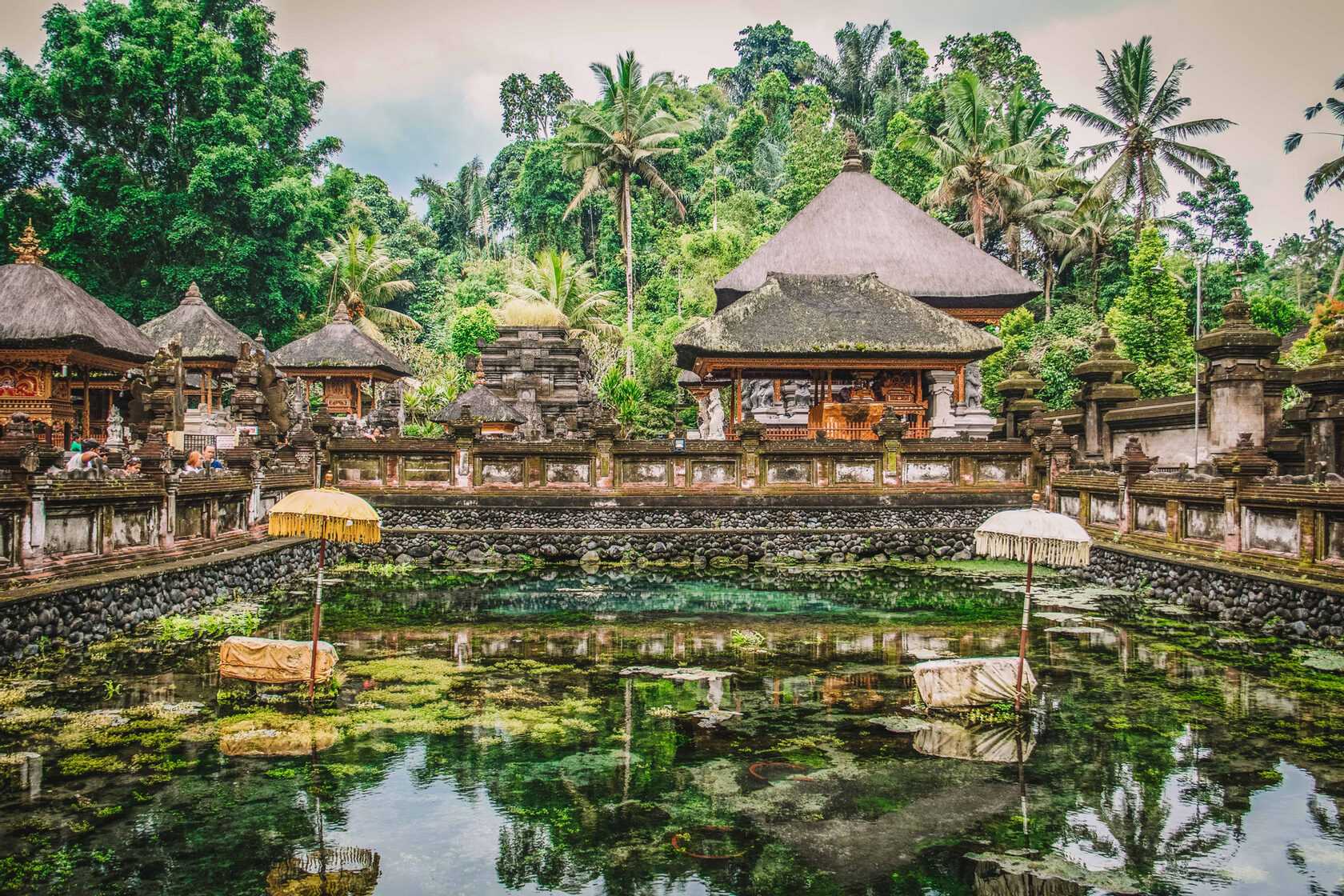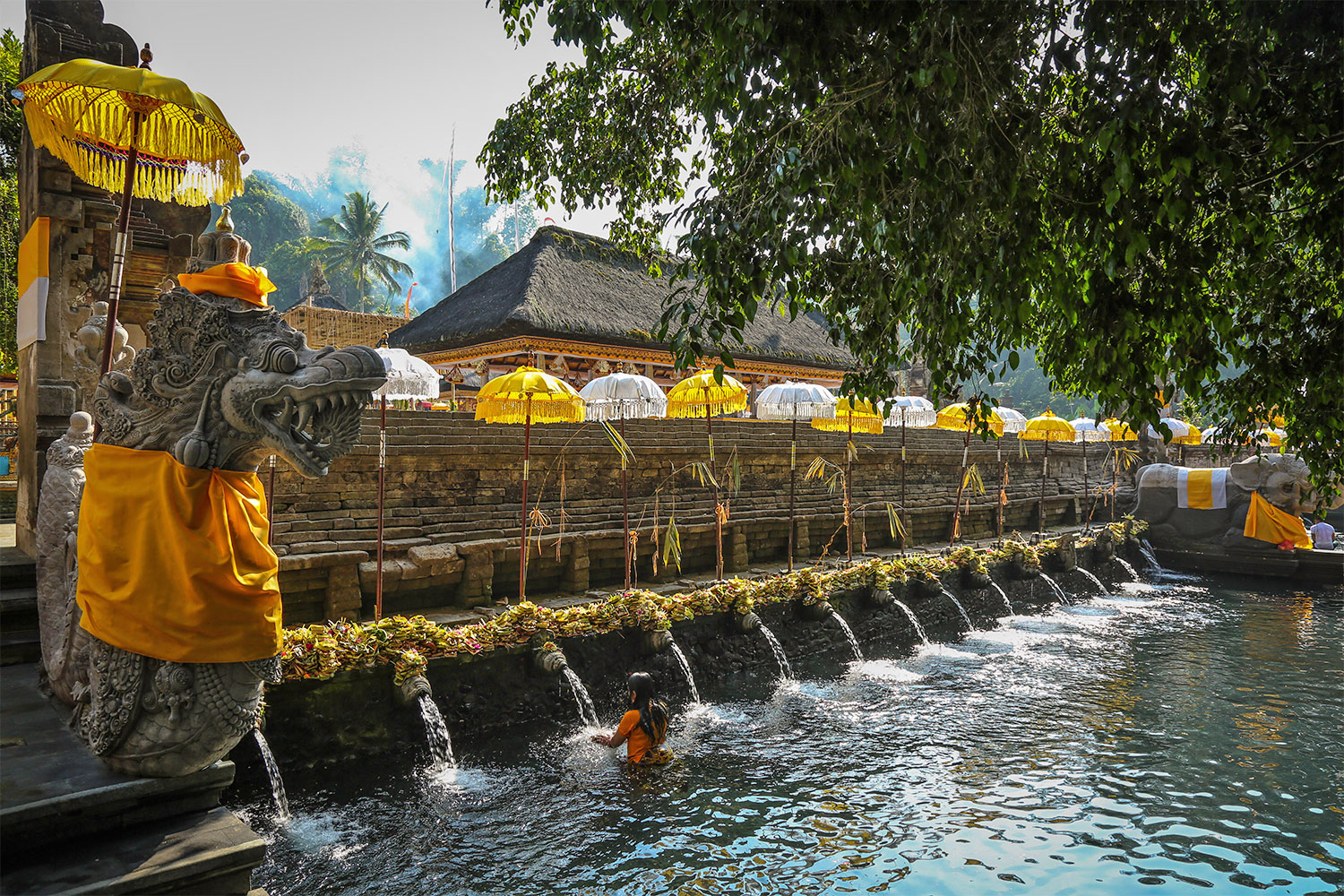Tirta Empul Temple
Tirta Empul Temple is one of Bali's most sacred and famous temples, located in the village of Tampaksiring, approximately 39 km from Denpasar and only 14 km from Ubud. It is known as the Holy Water Temple as it is an important place of purification and prayer for locals and tourists.
Pura Tirta Empul (Tirta Empul Temple): A Place of Sacred Water and Spiritual Cleansing
Pura Tirta Empul, located in the village of Tampaksiring, is one of the most revered temples in Bali. Built in 962 AD in honor of the god Vishnu, it is renowned for its sacred spring, whose waters, according to Hindu beliefs, purify both body and soul and even have healing properties.
Location and Architecture
The temple is situated in eastern Bali, about 39 km from Denpasar and 14 km from Ubud. Spanning a spacious, greenery-filled area, the complex is divided into three sections characteristic of Balinese temple architecture:
1. Jaba Pura (Outer Courtyard) – This area includes parking, souvenir shops, food and drink stands, and pavilions for preparing rituals.
2. Jaba Tengah (Central Courtyard) – Here you’ll find the famous purification pools.
3. Jeroan (Inner Courtyard) – The most sacred part of the complex, reserved for Balinese prayer and rituals.
Each courtyard is separated by gates adorned with traditional Balinese carvings.
The Sacred Spring and Pools
Within the complex are three pools, each serving a specific purpose:
• First Pool
This pool contains the temple’s sacred spring, called “amrita” (the water of eternal youth). Sand and algae are visible at the bottom, and the crystal-clear water appears to pulse with energy. This pool symbolizes the life force.
• Second Pool
Made up of three baths, this is where the “melukat” purification ritual begins, and visitors are welcome to participate. The bathing starts with the first spout on the left and involves 13 spouts in total. However, the 11th and 12th are reserved for the deceased and must not be used by tourists. These baths are believed to relieve stress, cleanse one’s karma, and foster harmonious relationships.
• Third Pool
This one is set aside for Balinese worshippers. It has seven fountains, each with a distinct function: health, prosperity, chakra cleansing, support for pregnant women, and more.
Beside the pools is another water area without spouts, where fish swim. For a small fee, you can feed them or take photos.
Other Sights within the Complex
There are around 20 pavilion shrines (bale) dedicated to various gods—Vishnu, Shiva, Brahma—where offerings and prayers take place. A banyan tree grows here, and together with other sculptures, is wrapped in sarongs to signify reverence for this holy spot. In a nearby pavilion, traditional musical instruments for a gamelan orchestra are on display.
Interesting Facts
1. Villa on the Hill – Close to the temple stands a villa popular with celebrities. In June 2017, former US President Barack Obama stayed there.
2. Local Market – At the entrance, you can buy sarongs, souvenirs, local drinks, and snacks.
Tips for Visitors
• Dress Code: A sarong (available for rent at the entrance) is required.
• Rituals: Respect local customs and follow the guidance of local attendants if you join the purification ceremony.
• Best Time to Visit: Morning or late afternoon to avoid crowds.
Why Visit Tirta Empul
Tirta Empul is not only a sacred site but also a monument of ancient architecture, surrounded by lush natural beauty. Experiencing traditional Balinese rituals, admiring the remarkable statues, and soaking in the serene atmosphere make this temple a must-see destination.
Pura Tirta Empul, located in the village of Tampaksiring, is one of the most revered temples in Bali. Built in 962 AD in honor of the god Vishnu, it is renowned for its sacred spring, whose waters, according to Hindu beliefs, purify both body and soul and even have healing properties.
Location and Architecture
The temple is situated in eastern Bali, about 39 km from Denpasar and 14 km from Ubud. Spanning a spacious, greenery-filled area, the complex is divided into three sections characteristic of Balinese temple architecture:
1. Jaba Pura (Outer Courtyard) – This area includes parking, souvenir shops, food and drink stands, and pavilions for preparing rituals.
2. Jaba Tengah (Central Courtyard) – Here you’ll find the famous purification pools.
3. Jeroan (Inner Courtyard) – The most sacred part of the complex, reserved for Balinese prayer and rituals.
Each courtyard is separated by gates adorned with traditional Balinese carvings.
The Sacred Spring and Pools
Within the complex are three pools, each serving a specific purpose:
• First Pool
This pool contains the temple’s sacred spring, called “amrita” (the water of eternal youth). Sand and algae are visible at the bottom, and the crystal-clear water appears to pulse with energy. This pool symbolizes the life force.
• Second Pool
Made up of three baths, this is where the “melukat” purification ritual begins, and visitors are welcome to participate. The bathing starts with the first spout on the left and involves 13 spouts in total. However, the 11th and 12th are reserved for the deceased and must not be used by tourists. These baths are believed to relieve stress, cleanse one’s karma, and foster harmonious relationships.
• Third Pool
This one is set aside for Balinese worshippers. It has seven fountains, each with a distinct function: health, prosperity, chakra cleansing, support for pregnant women, and more.
Beside the pools is another water area without spouts, where fish swim. For a small fee, you can feed them or take photos.
Other Sights within the Complex
There are around 20 pavilion shrines (bale) dedicated to various gods—Vishnu, Shiva, Brahma—where offerings and prayers take place. A banyan tree grows here, and together with other sculptures, is wrapped in sarongs to signify reverence for this holy spot. In a nearby pavilion, traditional musical instruments for a gamelan orchestra are on display.
Interesting Facts
1. Villa on the Hill – Close to the temple stands a villa popular with celebrities. In June 2017, former US President Barack Obama stayed there.
2. Local Market – At the entrance, you can buy sarongs, souvenirs, local drinks, and snacks.
Tips for Visitors
• Dress Code: A sarong (available for rent at the entrance) is required.
• Rituals: Respect local customs and follow the guidance of local attendants if you join the purification ceremony.
• Best Time to Visit: Morning or late afternoon to avoid crowds.
Why Visit Tirta Empul
Tirta Empul is not only a sacred site but also a monument of ancient architecture, surrounded by lush natural beauty. Experiencing traditional Balinese rituals, admiring the remarkable statues, and soaking in the serene atmosphere make this temple a must-see destination.

Legend of King Mayadenawa: The Mythical Origins of Tirta Empul’s Sacred Spring
As previously noted, the founding of Tirta Empul Temple is dated to 962 AD. Beyond its historical facts, this holy site is also woven into fascinating legends.
One of the best-known tales takes place in the Kingdom of Pejeng, once ruled by a powerful and cunning king named Mayadenawa, a master of black magic. He possessed the ability to transform into animals or objects, using this power not for good but to oppress his subjects.
Over time, the king grew excessively proud. He considered his might to be the equal of the god Indra and dared to proclaim himself Indra’s peer. To assert his dominance, Mayadenawa forbade his people from praying to the gods, destroyed all temples, and mocked their spiritual aspirations.
Seeing such abuse of power, the god Indra was enraged. He gathered an army and marched against Mayadenawa to punish him for his heresy. However, the crafty sorcerer, sensing his impending fate, decided to poison the water sources in order to destroy Indra’s warriors. Under cover of night, he carried out his evil plan, and by morning, those who drank the tainted water perished.
Enraged all the more, Indra struck the ground with his staff, creating a new spring whose waters possessed miraculous healing properties. He used this sacred water to revive his fallen army.
Realizing that his scheme had failed, Mayadenawa tried to flee. In his flight, he turned himself into stone to remain undetected. Indra shot an arrow into the stone, causing blood to flow out and form a river. Thus, the sorcerer was defeated, and his deeds were brought to an end.
A temple was built on the site of the sacred spring, which, from the 10th century onward, became a place of pilgrimage for the Balinese. They believe the spring water brings happiness, love, health, and cleanses the soul of sins.
This legend not only explains the origin of the sacred water source but also underscores its profound significance in Balinese spiritual culture, making Tirta Empul an essential part of the island’s history and traditions.
As previously noted, the founding of Tirta Empul Temple is dated to 962 AD. Beyond its historical facts, this holy site is also woven into fascinating legends.
One of the best-known tales takes place in the Kingdom of Pejeng, once ruled by a powerful and cunning king named Mayadenawa, a master of black magic. He possessed the ability to transform into animals or objects, using this power not for good but to oppress his subjects.
Over time, the king grew excessively proud. He considered his might to be the equal of the god Indra and dared to proclaim himself Indra’s peer. To assert his dominance, Mayadenawa forbade his people from praying to the gods, destroyed all temples, and mocked their spiritual aspirations.
Seeing such abuse of power, the god Indra was enraged. He gathered an army and marched against Mayadenawa to punish him for his heresy. However, the crafty sorcerer, sensing his impending fate, decided to poison the water sources in order to destroy Indra’s warriors. Under cover of night, he carried out his evil plan, and by morning, those who drank the tainted water perished.
Enraged all the more, Indra struck the ground with his staff, creating a new spring whose waters possessed miraculous healing properties. He used this sacred water to revive his fallen army.
Realizing that his scheme had failed, Mayadenawa tried to flee. In his flight, he turned himself into stone to remain undetected. Indra shot an arrow into the stone, causing blood to flow out and form a river. Thus, the sorcerer was defeated, and his deeds were brought to an end.
A temple was built on the site of the sacred spring, which, from the 10th century onward, became a place of pilgrimage for the Balinese. They believe the spring water brings happiness, love, health, and cleanses the soul of sins.
This legend not only explains the origin of the sacred water source but also underscores its profound significance in Balinese spiritual culture, making Tirta Empul an essential part of the island’s history and traditions.

Tirta Empul Temple (Pura Tirta Empul) is located here
Or you can visit this temple on an excursion with a local guide, who will tell you more interesting facts about this amazing place, and you also have a unique opportunity to undergo a local ceremonial purification rite.
https://mos-activity.com/en/excursion-sebatu
https://mos-activity.com/en/excursion-sebatu
